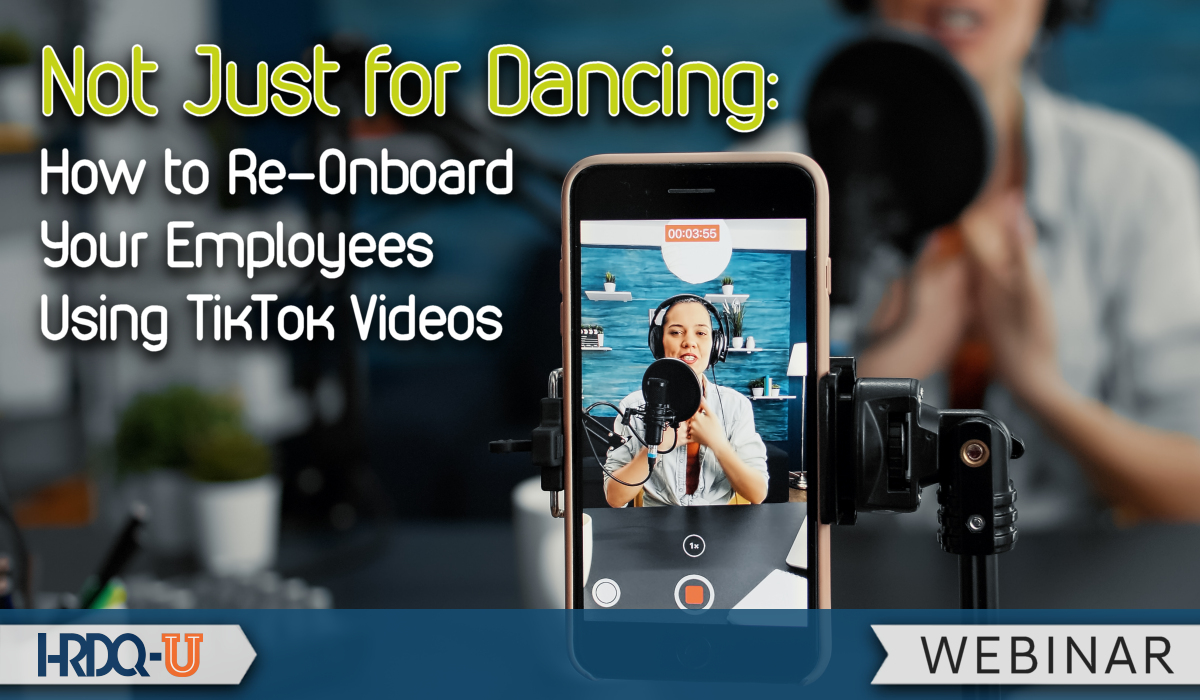- 827 Lincoln Ave. #B-10 West Chester, PA 19380
- support@hrdq.com
- +1-610-279-2002
Quick Links
Menu
Featured Topics
Menu
Total Results
We could not find what you're looking for. Please try again.No Record Found

Have you heard of the cultural phenomenon that is the social media platform, TikTok? With its short-form videos catering to viewers’ interests and searches, 30 minutes on the app flies by in a flash. It’s time to adapt these binge-able principles to learning and development!
Re-onboarding employees can be a daunting task, especially for those who have been away from the workplace for an extended period. Remote or hybrid work has become the new normal, and employees may need to be re-onboarded to learn new procedures and protocols. But fear not, we have a solution. In this webinar, we’ll explore how organizations can leverage TikTok videos to make the re-onboarding process more engaging and effective!
Let’s face it, many onboarding and re-onboarding methods are outdated. This is your chance to show your employees that they’ve chosen the best possible place to work! We’ll discuss how traditional methods may not be as effective in today’s remote work environment, and why organizations need to adapt their approaches. With the help of TikTok principles, we’ll meet the needs of employees in a fun and engaging way.
We’ll dive into how TikTok-style videos can be used to create effective re-onboarding content, such as tutorials, challenges, and behind-the-scenes glimpses of the workplace. We’ll also explore how organizations can use TikTok-style videos to showcase their culture, values, and mission, fostering a sense of community and connection among employees.
Throughout the webinar, we’ll provide practical tips and advice for creating TikTok-style videos that are both informative and entertaining. We’ll cover best practices for scripting, filming, and editing, as well as incorporating music and other creative elements into the content. We’ll also show you how to measure the effectiveness of TikTok videos and use analytics to refine your content and improve engagement.
By the end of the webinar, attendees will have a better understanding of how TikTok-style videos can be used as a tool for re-onboarding employees. With practical tips and advice that can be implemented immediately in their own organizations, attendees will leave feeling motivated and ready to engage and re-engage employees in a fun and innovative way.


Using TikTok for Talent Development
In this course, Vanessa Alzate teaches you how to leverage short-form video to transform your learning and development strategy.
Vanessa Alzate is the Founder and CEO of Anchored Training. She received a BA in both Communications and Political Science from Rutgers University and an MS in Corporate and Organizational Communication from Northeastern University. For over a decade, she has consulted with many mid-large organizations in industries ranging from pharmaceutical sales to fashion to develop training strategies tailored to each individual organization and team.
Throughout her career, Vanessa has excelled in assisting companies and individuals to expand their industry knowledge through innovative eLearning and classroom curriculum, while continuing to add consistently to her own education and training. She is passionate about keeping learners at the forefront of all learning initiatives and finding new and inventive ways to active, collaborate with, and engage learners empowering them to grow personally and professionally.
Anchored Training partners with businesses to create learning solutions for your organization that utilizes our three principles: Edutain, Activate, and Collaborate. By following our proven process to create better training, you will keep your project on time and on budget.
Learn more at AnchoredTraining.com
Training Tools for Developing Great People Skills
This event is sponsored by HRDQ. For 45 years HRDQ has provided research-based, off-the-shelf soft-skills training resources for classroom, virtual, and online training. From assessments and workshops to experiential hands-on games, HRDQ helps organizations improve performance, increase job satisfaction, and more.
Learn more at HRDQstore.com

Sign up to be notified of upcoming live webinars, in-depth workshops, podcasts, blog posts, promotions and much more. Stay ahead of the curve and subscribe for FREE today!